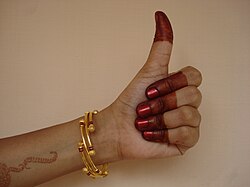Top Qs
Timeline
Chat
Perspective
List of mudras (dance)
Hand gestures in Indian classical dance From Wikipedia, the free encyclopedia
Remove ads
One of the most striking features of Indian classical dance and dances of Thailand,[1] Cambodia, Laos, Myanmar and the Malay world is the use of hand or finger gestures called mudras. Two classifications of mudras are used in Indian classical dance, Thai dances, Cambodian dances, Lao dances, Burmese dances and Malay dances, and are a prominent part of the dancer's vocabulary.
This article has multiple issues. Please help improve it or discuss these issues on the talk page. (Learn how and when to remove these messages)
|
Bharatanatyam Mudra
Thai Mudra
Khmer Mudra
Lao Mudra
Burmese Mudra
Malay Mudra
Balinese Mudra
Remove ads
Background
Summarize
Perspective
Nandikeshvara's Abhinaya Darpa (a descriptive primer for dancers) mentions that the dancer should sing the song by the throat, express the meaning of the song through hand gestures, show the state of feelings in the song by eyes, and express the rhythm with his or her feet.
From the Natya Shastra, a text on the arts, this quotation and translation is often quoted by Indian classical dance instructors:
- "Yato hastastato drishtihi"..."Where the hand is, the eyes follow"
- "Yato drishtistato manaha"..."Where the eyes go, the mind follows"
- "Yato manastato bhavaha"..."Where the mind is, there is the feeling"
- "Yato bhavastato rasaha"..."Where there is feeling, there is mood/flavour, sweetness (i.e., appreciation of art; aesthetic bliss)"
So vast are the subtleties expressed in the hand gestures of hasta that the vastness of what being human entails, and perhaps even what the entire universe contains, might be expressed by the dancer.
Hence as 'hasta' form a distinct coded language which brings a unique poetic element while performing, so too when abhinaya (traditional facial expressions), pose (attitude), and rhythm complete the language, the dancer may express practically anything and everything to an attentive audience.
Remove ads
Gestures
Summarize
Perspective
Bharatanatyam
In Bharatanatyam, the classical dance of India performed by Lord Nataraja, approximately 48 root mudras (hand or finger gestures) are used to clearly communicate specific ideas, events, actions, or creatures in which 28 require only one hand, and are classified as `Asamyuta Hasta', along with 23 other primary mudras which require both hands and are classified as 'Samyuta Hasta'; these 51 are the roots but the branches permit of many more mudra, some of which are used primarily as aesthetic or decorative.
Khmer dances
In Khmer dances, mudras are known as kayvikear dai (កាយវិការដៃ). All of the mudras symbolize plants.
Thai dances
Remove ads
See also
References
Further reading
External links
Wikiwand - on
Seamless Wikipedia browsing. On steroids.
Remove ads








































